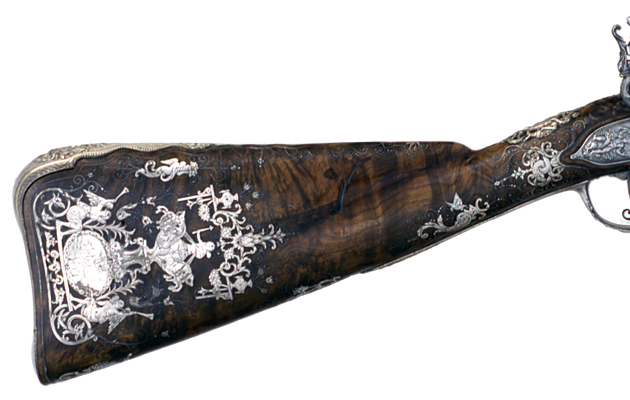French gunmaker Betrand Piraube made this gun, in collaboration with exceptionally skilled craftsmen. The Piraube was used as a royal gift from the French king. Mark Murray-Fletcher, senior curator at the Royal Armouries, tells the story.
Bertand Piraube was a gunmaker working in France in the seventeenth century. As part of our series on historical hunting weapons, Mark Murray-Fletcher explains the birth of an exquisite piece.
THE PIRAUBE
As technical innovation in gunmaking progressed so did the uses to which the firearm would be put. One was as a luxury item. A status symbol to show your wealth and sophistication. By the late 17th century, the application of decoration on firearms had reached extraordinary levels.
A fine example of this is a magnificent gun by Piraube in the Royal Armouries collection. It is believed to be a gift from Louis XIV (1638-1715) of France to Charles Lennox, first Duke of Richmond and Gordon. He was the natural son of King Charles II. Lennox visited Paris in 1681/2 and 1685. It is thought the gun might have been presented by the king during one of these visits. Alternatively, it might have been a gift to Charles II who passed it on to his son.
Clearly it was intended as a luxury gift. The extraordinary level of decoration was enhanced by a solid silver barrel. It is not only decorative but also capable of being fired. Preserved in the family until 1958, the gun raised a world record price of 2,100 guineas when it was purchased by the Royal Armouries.
It was created by the French gunmaker Bertrand Piraube in about 1685. He appears to have been working in St Germain-en-Laye from 1663. And in 1670, was commissioned to work in the Galeries du Louvre, where the best craftsmen attached to the royal court worked.
For a gun of this quality a professional designer would have been called upon to prepare designs for the patron’s approval. It is likely the designer was Jean Berain, chief designer to the Court of Louis XIV from 1674.
The silver barrel is chased with trophies of arms, foliate scrolls and a figure of Mars. The lock plate and other steel fittings were chiselled with classical imagery by a medallist such as Jerôme Roussel. The designs were based on those published in the 1660s by Thuraine and Le Hollandois.

An engraving showing designs for a flintlock sporting gun by Thuraine and Le Hollandois.
It is inscribed “PIRAUBE AUX GALERIES”. The butt plate is decorated with the figure of a victorious general in Roman armour, the screw plate is chased and pierced with Apollo and the silver escutcheon plate has a portrait of Louis XIV as a Roman emperor.
The walnut stock of the Piraube is inlaid with scrollwork in silver wire. On either side of the butt is an oval medallion depicting a camp scene with the sun god (Louis XIV) in a chariot with a sceptre topped with a fleur-de-lis. Such a fine weapon was a collaboration between a number of skilled craftsmen working at the top of their game.





